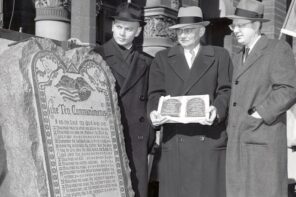The headline “Biblical Angels Were Just ‘Lucid Dreams’” intrigued me. According to the article, participants in a recent study who were instructed to try to visualize angels during states of lucid dreaming had, in some cases, succeeded in having experiences which seemed to parallel the encounters of Elijah and other Hebrew prophets with angelic messengers, as recorded in the Bible.
Still, I was put off by the dismissiveness of the phrase “just lucid dreams,” and also by the suggestion that the visions of mystics and prophets reported in the Bible and elsewhere are merely imaginary events that can be reproduced at will.
In my own experience, lucid dreams, while clearly owing a lot to the imagination, often contain a spiritual element which is not merely “imaginary.” In other words, the imagination in this instance is not just a faculty for creating fictions and illusion, but equally a portal into another realm of experience—a realm of heightened awareness and intense spiritual aliveness which challenges our very notions of what is real and what it means to be “awake.”
The music we hear during lucid dreams is rapturous and drenched in feeling; the colors are more subtle and vibrant than the ones we see in the “real world”; the aromas and tastes are more real than real; the sex is explosive and ecstatic; and the insights are profound, if frequently difficult to put into words. A lucid dream, in other words, can be an intoxicating glimpse of what life might be like if we lived, as the Zen masters recommend, fully in the now: alert, fiercely present, and with wide-open hearts.
In 1902, the British writer and occultist, Hugh Calloway, wrote of his first lucid dream:
Instantly the vividness of life increased a hundred fold. Never had the sea and the sky and trees shone with such glamorous beauty; even the commonplace houses seem alive and mystically beautiful. Never had I felt so absolutely well, so clear-brained, and so inexpressibly free!
The intensity of experience in lucid dreams is one reason so many people today are pursuing them. Books have been written and workshops offered on how to cultivate these visionary experiences, which typically occur just after the onset of sleep, or during the process of awakening. We remain aware that we are dreaming and can exercise a certain degree of control over the imagery and action of the dream.
While scientists only started studying lucid dreams in recent decades, references to them can be found as early as the writings of the fifth-century Catholic saint, Augustine of Hippo. The twelfth-century Sufi philosopher and mystic, Ibn El-Arabi, instructed his students to take control of the imagery in their dreams. They also figure in a Tibetan tradition called Dzogchen, in which meditators practice mastery of lucid dreaming as a training for navigating the Bardo, the after-death state that Buddhists believe helps to determine one’s future incarnation.
The indigenous Senoi people, who live in the mountain jungles of central Malaysia, believe that by confronting and overcoming dangers in lucid dreams (like fire, floods, and tigers), and by consciously guiding those dreams to good endings, we can master our fears and have a positive impact on the events in waking life. More recently, Australian psychologist Milan Colic developed a method which employs lucid dreaming to help control nightmares and treat depression.
Working with dreams to gain psychological insight is a cornerstone of psychoanalysis, whose founder Sigmund Freud believed that dreams reveal, in the symbolic language of the subconscious, aspects of the personality of the dreamer and offer keys to understanding their emotional complexes. In his pioneering work The Interpretation of Dreams, he argued that most dreams are a form of wish fulfillment in which the psyche attempts to resolve suppressed conflicts, often originating in childhood or early adolescence, and frequently of a sexual nature.
Freud’s protege Carl Jung broke with his mentor in asserting that dreams were not just the byproducts of inner conflicts and psychopathology, but offered guidance for achieving psychic wholeness. Jung wrote that a dream is like “a small hidden door to the most deep hidden and secret corners of the psyche… In our dreams we take the form of a more universal, true and eternal man.” One of the function of dreams, according to Jung, is to provide an entree to what he called “the collective unconscious,” a repository of the wisdom of the human race which is often cloaked behind the more superficial layers of the mind.
Both Jung and Freud were aware of the existence of lucid dreams. Freud, who was reportedly disturbed by the sexual content of one of his own lucid dreams, wrote in the second edition of The Interpretation of Dreams, “There are people who are quite clearly aware during the night that they are asleep and dreaming and who thus seem to possess the faculty of consciously directing their dreams.” Traditional Jungians, on the other hand, sometimes object to the conscious element in guiding lucid dreams. In their view, dreams belong exclusively to the subconscious mind and should not be meddled with.
Yet I suspect that Jung himself was not as upset as some of his orthodox followers appear to be at the unconventional nature of lucid dreams. The great analyst had experienced lucid visionary states, both in sleep and in waking, and he understood that, while one can indeed remain conscious during visions, they are not merely products of the conscious mind. On the contrary, for Jung such experiences involve contact with an awareness which is more than merely personal. He reportedly had premonitions and received messages during these states.
Lucid visionary states have been sought by a wide variety of cultures, not just for the sense of euphoria, freedom, and radiant aliveness they convey, but because they were believed capable of transforming and uplifting the individual to a divine level. Some Native American cultures went on spirit quests in remote places to seek visions which would result in positive new directions in life, both for the individual and the tribe. In ancient Greece, sick people journeyed to temples dedicated to Aesculapius, the God of medicine, to engage in incubation, a ritual designed to produce lucid dreams, which they hoped would provide healing or the answer to a troubling question.
This ancient practice of incubation was the topic of a recent study conducted by Dr. Deirdre Barrett at Harvard Medical School in which the participating students were instructed to focus on a problem of a personal or academic nature just prior to falling asleep. Of those who remembered their dreams when they woke up, over half reported that they contained solutions to the problem.
This research dramatically confirms the validity of the oft-repeated recommendation to, “sleep on it.” It also supports the age-old intuition that dreams are sometimes not just dreams, as we may dismiss them, but keys that unlock a deeper wisdom within ourselves. Lucid dreams, in particular, offer a rare bridge between the state of waking and sleep, which may provide clues to the nature of consciousness itself. Science is just now beginning to demonstrate that they are also invaluable tools for cultivating creativity, self-understanding, and personal growth.
So perhaps we should amend that reductive and condescending headline explaining away biblical prophecy—“Biblical Angels Were Just ‘Lucid Dreams’”—to the far richer and more intriguing statement, “Lucid Dreaming Makes Us All Potential Prophets.”




